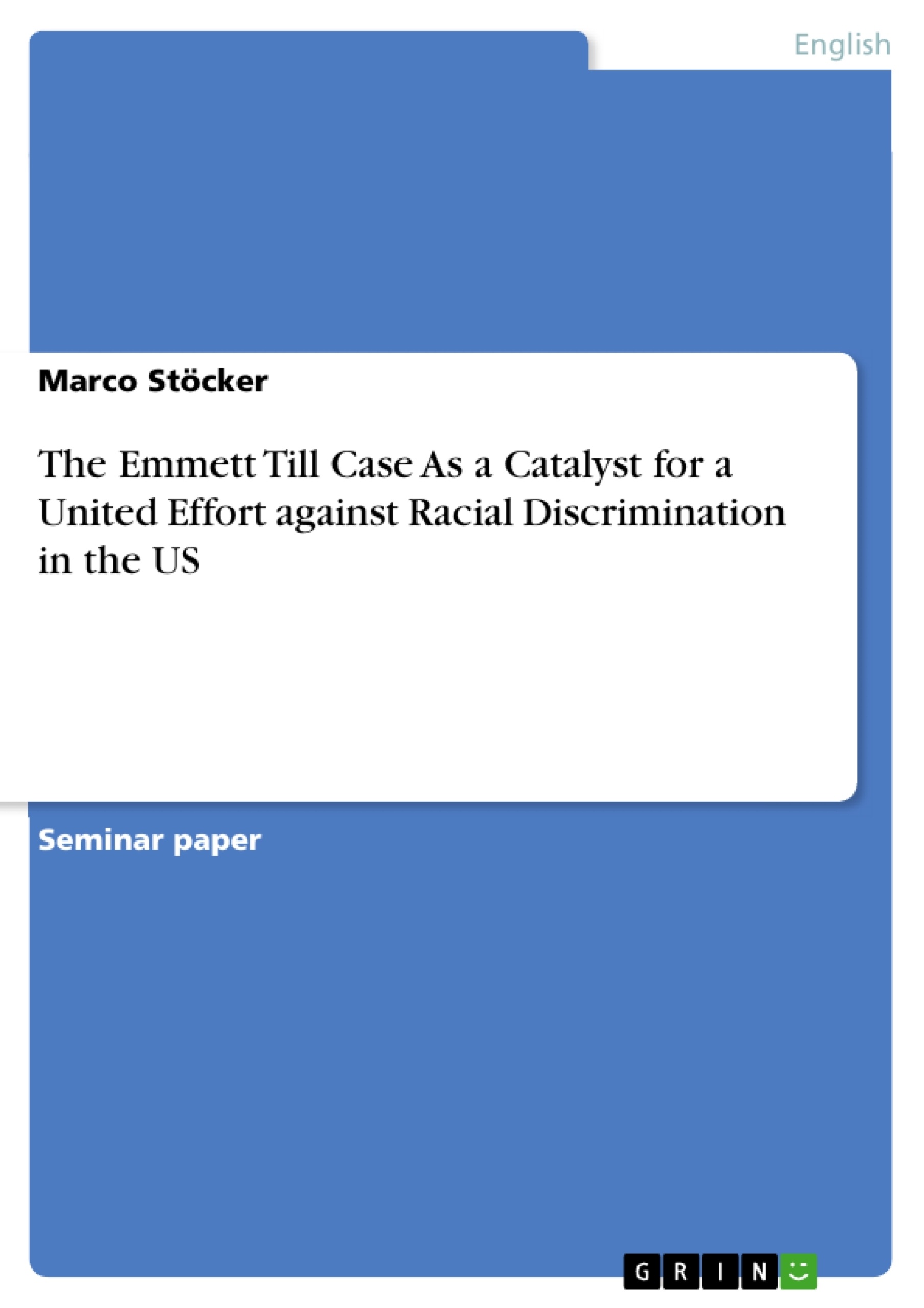You may not realize it but you are making history. Bobo is not the only Negro that was lynched in Mississippi, but this is the first trial of its kind that has ever been held in Mississippi. The kind of death your son died is responsible for this trial.
(Hudson-Weems, 2006, p.3)
This citation is taken from the unpublished biography of the energetic Civil Rights activist Rayfield Mooty. It addresses to Mrs. Mamie Till Bradley, mother of Emmett Louis Till. The 14-year-old Emmett Till was from Chicago (IL) visiting his relatives in the Mississippi Delta in August 1955 where he fell victim to race related violence. The black boy reportedly flirted with a white woman; an absolute taboo in the Jim Crow South. Her husband and his half-brother, furious about the incident, kidnapped Emmett, mutilated him, shot him in the head and disposed his body in the Tallahatchie River. After the body was found three days later, Mamie Till Bradley insisted on a public funeral with an open casket to “let the world see, what they did to [her] boy” (cf. Whitfield, 1988, p.23).
Although racially motivated lynchings were nothing out of the ordinary in Mississippi, tens of thousands attended the funeral and the media attention was enormous. Goldsby (1996, p.254) refers to it as the “first great […] media event of the civil rights movement.” Also other scholars and journalists refuse to date the Civil Rights Movement from the famous Montgomery Bus Boycott and assume that the Emmett Till murder marks the emergence of the Movement. When reviewing the scientific discussion, it is striking that predominantly more recent literature mentions the Emmett Till case as a trigger or as a catalyst for the Civil Rights Movement.
This paper is to shed some light on the question why Emmett Till could evolve into such a historically important person given the circumstances that race related violence in Mississippi was nothing out of the ordinary in the 1950s. Therefore, after a brief evaluation of the race relations in Mississippi and in Chicago, the Emmett Till murder case will be examined. In a later part, the paper will address the prerequisites necessary to make the case that famous. Special attention will be given to the commitment of Mamie Till Bradley and the media landscape in the US in the 1950s.
Table of Contents
- Introduction
- Race Relations in the South and in Chicago in the 1950s
- In Chicago
- In the South
- The Emmett Till Case
- The Murder of Emmett Till
- Emmett Till’s Body Returns to Chicago
- The Funeral
- The Trial
- Emmett Till as a Catalyst for the Civil Rights Movement
- Age and Provenance
- Commitment of Mamie Till Bradley
- The Interest of the Labor Unions for the Case
- The NAACP and the Till Case
- National Response and the Influence of the Media
Objectives and Key Themes
This paper examines the circumstances that led to the murder of Emmett Till in 1955 and analyzes why this specific case gained such significant national and international attention, despite the prevalent racial violence in the American South. The author seeks to understand how the murder of Emmett Till, a 14-year-old boy from Chicago, became a catalyst for the Civil Rights Movement.
- The brutal reality of racial violence in the Jim Crow South.
- The role of media and visual imagery in raising awareness and galvanizing public opinion.
- The commitment of Mamie Till Bradley, Emmett's mother, and other key individuals in amplifying the case.
- The involvement of labor unions and organizations like the NAACP in supporting the cause.
- The significance of Emmett Till's age and background in generating widespread shock and sympathy.
Chapter Summaries
The paper begins with a brief introduction that presents the context of the Emmett Till case and its historical significance. It then delves into the racial climate of the South and Chicago in the 1950s, highlighting the stark contrast in race relations between the two regions. The second chapter details the events leading to Emmett Till's murder, focusing on the details of his encounter with Carolyn Bryant and the subsequent kidnapping and brutal killing. The author then examines the aftermath of the murder, including the return of Till's body to Chicago, the public funeral, and the subsequent trial of his killers. The paper concludes with a detailed analysis of why the Emmett Till case gained such unprecedented attention and how it acted as a catalyst for the Civil Rights Movement. The author highlights the role of Mamie Till Bradley, the media, labor unions, and the NAACP in amplifying the case and raising awareness about racial injustice.
Keywords
The main keywords and focus topics of this paper include: Emmett Till, Civil Rights Movement, Racial Discrimination, Jim Crow South, Lynching, Mamie Till Bradley, Media Coverage, Labor Unions, NAACP, Visual Imagery, Public Opinion, and Social Justice.
- Citar trabajo
- Marco Stöcker (Autor), 2012, The Emmett Till Case As a Catalyst for a United Effort against Racial Discrimination in the US , Múnich, GRIN Verlag, https://www.grin.com/document/229734



